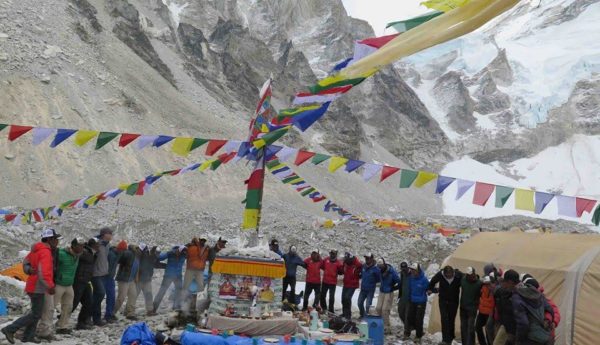Touchstone member and Bay area resident, Gulnur Tumbat spent much of the spring 2014 season on Everest. She wrote a bit about her experience for the Touchstone blog.
Getting ready for an 8000-meter expedition is a big deal. It is even bigger for someone like me who has a day job and doesn’t get to climb big mountains too often. Extensive financial commitment, months if not years of mental preparation, time off from work, organization of the life left behind including the apartment and the dog etc for 2+ months… In the midst of this craziness, which I am not doing justice here in any way, one has to be physically training really hard.
Professional mountaineers always say the best way to train to climb a big mountain is to climb big mountains. Period. They are wise. But living a rather “normal” life makes it too difficult if not impossible for someone like me to regularly climb real mountains. Now it was my time to go climb Everest. I am an endurance athlete. I run, bike, and rock-climb. I work out 5-6 days a week. Mostly I run long distances. Aerobically I have been in fantastic shape. Yet big mountains are a different story. You need to be strong, really strong.
While searching and trying work-outs to achieve more of that for years in the city, I discovered a boot-camp class very randomly at my climbing gym, which is a full-facility gym with all kinds of classes but none got my attention before. Kristine Rios, the super experienced trainer, knew what she was doing. Proper warm-ups and intense crazy work-outs were capped by proper stretching. I was impressed by how she took every step seriously and paid attention to improper forms if any. She did everything with detail to minimize injuries. Every class she’d come up with something different and interesting for people like me who really wish not to be in a gym. Nothing became repetitive or boring. She has everything for you including some Cross-Fit-like moves without the irritating cult-ness associated with the name. I was able to observe how much stronger I was getting and felt fantastic after only the first 6-months. I am thankful to her for that.

During my time on Everest, rock and ice avalanches were happening every day, multiple times a day. They were so frequent we were no longer paying attention to them. It was a normal daily thing for us at Everest base camp.
However, the avalanche in the morning of April 18 was different. I was up early and in the dining tent with our base camp manager, trying to figure something on my laptop before everyone got up. We jumped from our seats with the sound of the avalanche and screams coming from outside. It was our lead guide telling us to get on the radio right away. We got out and saw him, our sirdar, and a few others putting their crampons on and running towards the icefall. It was a big avalanche right below Camp 1 at a section that has been thought super dangerous. Lots of Sherpas from different teams has left the base camp early in the morning to carry loads to higher camps. It was surreal. I had been to Everest base camp 10 years ago to collect data for my research on risk marketing and risk consumption. I have been climbing for a long time. I read and continue to read all kinds of stories of accidents on Everest as part of my research. Yet it was a weird and super sad experience to be right there. Here I was in the middle of one happening right in front of my very eyes. It was big and it was real.

Our camp was one of the closest to the icefall so we watched the whole rescue unfold. Our camp also became one of the centers of the rescue operation. It was one of the worst days in my life. Since there was no place for helicopters to land on the icefall, all the bodies were brought down at the end of a long line. 13 bodies. 3 bodies were still under the ice avalanche, unreachable somewhere deep in the mountain. We watched them brought down one by one. It broke me big time and everyone else in my team. It was the deadliest day in the history of Everest expeditions since 1900’s. And at the beginning of the season. We lost 5 Sherpa from our team; 5 people we were dancing with around our Puja altar just the day before.
At the end, all Everest climbs this season on the south side of the mountain ended up canceled due to a big tragedy that my team with 5 lost Sherpas was also a part of. There was so much sadness but when the mountain is ready to let us climbers on it, I will be there again. I will continue training and be even stronger next time.

